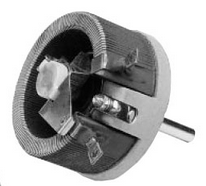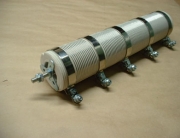50 Watt Rheostat – High Power Rheostat Example
Rheostats have been used in industry for over 50 years. A rheostat has the electrical  characteristics of being able to offer an adjustable resistance specified at time of ordering the rheostat and being able to dissipate significant power – 50 watts in the case of the APR50 rheostat. This is useful in applications such as:
characteristics of being able to offer an adjustable resistance specified at time of ordering the rheostat and being able to dissipate significant power – 50 watts in the case of the APR50 rheostat. This is useful in applications such as:
- motor control
- lighting control
- industrial controllers
- sound level control
- laboratory test setups
Rheostat Specification
Parameters used to specify a rheostat include the following:
- Resistance tolerance – typically +- 10% in the case of the APR series rheostats.
- Insulation Resistance – Typically 100M ohms at 500 volts d.c.
- Rotational life – this is an important specification. For rheostat applications requiring frequent adjustment of the rheostat the number of operational rotations is important. Lesser quality rheostats with poor quality construction, wiper assembly and resistance winding may only have a rotational life of a few hundred rotations. The APR 50 rheostat has a rotational life of a minimum of 10,000 rotations.
- Mechanical rotation angle – this parameter specifies the amount of rotation, measured in degrees, that the rheostat is mechanically adjustable. The APR series rheostats have a mechanical rotation angle of 290 degrees.
- Termination options – this specifies how wiring can be connected to the rheostat. The APR series offers both solder tag and industry standard ‘quick connect’ termination.
Temperature Deratings Of Rheostats
Like all wire wound resistors, rheostats exhibit a ‘derating’ characteristic. As the ambient temperature increases the percentage of rated power decreases. This is an important parameter for design engineers to take into account. A 50 watt rated rheostat will have a power rating of around 40 watts at a temperature of 75 degrees C. So the ambient temperature of the operating environment for the rheostat needs to be taken into account when selecting the appropraite power rating.

